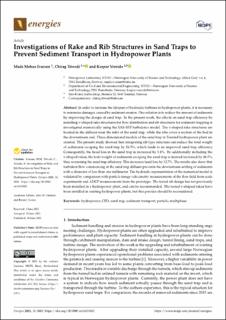| dc.contributor.author | Ivarson, Mads Mehus | |
| dc.contributor.author | Trivedi, Chirag | |
| dc.contributor.author | Vereide, Kaspar | |
| dc.date.accessioned | 2021-10-07T09:27:52Z | |
| dc.date.available | 2021-10-07T09:27:52Z | |
| dc.date.created | 2021-06-28T13:37:01Z | |
| dc.date.issued | 2021 | |
| dc.identifier.citation | Energies. 2021, 14 (13), . | en_US |
| dc.identifier.issn | 1996-1073 | |
| dc.identifier.uri | https://hdl.handle.net/11250/2788339 | |
| dc.description.abstract | In order to increase the lifespan of hydraulic turbines in hydropower plants, it is necessary to minimize damages caused by sediment erosion. One solution is to reduce the amount of sediments by improving the design of sand trap. In the present work, the effects on sand trap efficiency by installing v-shaped rake structures for flow distribution and rib structures for sediment trapping is investigated numerically using the SAS–SST turbulence model. The v-shaped rake structures are located in the diffuser near the inlet of the sand trap, while the ribs cover a section of the bed in the downstream end. Three-dimensional models of the sand trap in Tonstad hydropower plant are created. The present study showed that integrating rib type structure can reduce the total weight of sediments escaping the sand trap by 24.5%, which leads to an improved sand trap efficiency. Consequently, the head loss in the sand trap is increased by 1.8%. By additionally including the v-shaped rakes, the total weight of sediments escaping the sand trap is instead increased by 48.5%, thus worsening the sand trap efficiency. This increases head loss by 12.7%. The results also show that turbulent flow commencing at the sand trap diffuser prevents the downstream settling of sediments with a diameter of less than one millimeter. The hydraulic representation of the numerical model is validated by comparison with particle image velocimetry measurements of the flow field from scale experiments and ADCP measurements from the prototype. The tested rib design has not previously been installed in a hydropower plant, and can be recommended. The tested v-shaped rakes have been installed in existing hydropower plants, but this practice should be reconsidered. | en_US |
| dc.language.iso | eng | en_US |
| dc.publisher | MDPI | en_US |
| dc.rights | Navngivelse 4.0 Internasjonal | * |
| dc.rights.uri | http://creativecommons.org/licenses/by/4.0/deed.no | * |
| dc.title | Investigations of Rake and Rib Structures in Sand Traps to Prevent Sediment Transport in Hydropower Plants | en_US |
| dc.type | Journal article | en_US |
| dc.type | Peer reviewed | en_US |
| dc.description.version | publishedVersion | en_US |
| dc.source.pagenumber | 16 | en_US |
| dc.source.volume | 14 | en_US |
| dc.source.journal | Energies | en_US |
| dc.source.issue | 13 | en_US |
| dc.identifier.doi | 10.3390/en14133882 | |
| dc.identifier.cristin | 1918931 | |
| cristin.ispublished | true | |
| cristin.fulltext | original | |
| cristin.qualitycode | 1 | |

